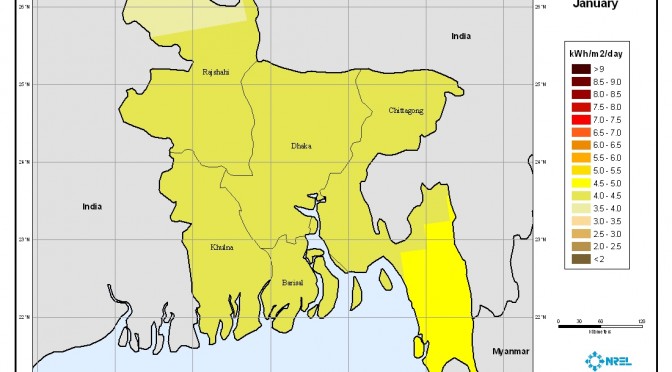By Mohammad Alauddin
Being aware of the finite stock of fossil fuels and their negative impact on the environment, countries across the world are now leaning towards renewable energies like solar energy, wind energy, bio-energy, hydropower, geothermal and ocean energy in efforts to ensure energy security.
The use of renewable energy has risen considerably in recent times, both in developed and in developing countries. REN21’s Renewables 2014 Global Status Report indicates that renewable energy provided an estimated 19% of global energy consumption in 2012 compared to 16.7 % in 2010. More than hundred countries now have renewable energy policy of one kind or the other.
Keeping pace with the global trend, Bangladesh has also attached due importance to development of renewable energy. National plans — Five Year Plan, Power System Master Plan — and policy documents including National Energy Policy, Industrial Policy 2010 underscored renewable energy. Development of renewable energy has been identified as one of the programmes of Bangladesh Climate Change Strategy and Action Plan. Renewable energy options are also included in the Bangladesh National Building Code. A dedicated policy, Renewable Energy Policy of Bangladesh, has been in force since 2009, which envisions having 5% power from renewable energy sources by 2015 and 10% by 2020. The government has established Sustainable and Renewable Energy Development Authority (SREDA) to promote renewable energy and energy efficiency. To strengthen international cooperation, Bangladesh became one of the initial members of the International Renewable Energy Agency (IRENA), the only inter-governmental agency working exclusively on renewable energy. Those endeavours manifest Bangladesh’s commitment towards development of renewable energy.
Bangladesh receives an average daily solar radiation in the range of 4-5 kWh/m². Encouraged by the availability of solar radiation, Power Division has initiated a programme to generate 500 MW of solar-based electricity. Under this programme, projects for electrification of rural health centres, educational institutions, E-centres at union levels, religious establishments and remote railway stations are required to be implemented by authorities concerned. Private sector is expected to implement commercial projects like Solar Irrigation, Solar Mini Grid, Solar Park and Solar Rooftop applications.
The government is gradually meeting part of the lighting and cooling load of public offices by installing solar panels. The national capacity of solar power development currently exceeds 150 MW. Most of the capacity addition is from Solar Home Systems (SHS) implemented by Infrastructure Development Company Limited (IDCOL), a government-owned financial institution. Until recently, more than 3 million SHSs have been installed with aggregated capacity of about 135 MW. The international community recognises Bangladesh’s SHSs as the fastest growing solar power dissemination programme in the world.
Today, hydropower makes up the largest share of electricity generated from renewable sources as the global capacity reaches 1,000 GW. The only hydroelectric power plant was established at Kaptai with present installed capacity of 230 MW. Bangladesh Power Development Board (BPDB) identified two other sites at Sangu (140 MW) and Matamuhuri (75 MW) for large hydropower plants. Further exploitation of hydropower appears to be limited due to flat terrain of Bangladesh. Several studies have identified a few sites having potential ranging from 10 kW to 5 MW, but no appreciable capacity has yet been established.
Bio-energy is energy derived from any form of biomass, including bio-heat, bio-power, and bio-fuel. Bangladesh Agricultural University and Bangladesh Council of Scientific and Industrial Research (BCSIR) launched biogas technology in the country in early 1970s. Against an estimated potential of 4 million biogas plants about 70,000 plants have been established so far throughout the country. Tapping potential of biomass, two rice husk-based power plants of 250 kW at Gazipur and 400 kW at Thakurgaon, and seven poultry waste-based power plants at different sites with aggregated capacities exceeding 1 MW, have been established at the initiative of private sector with support from IDCOL.
Except for two pilot wind-power plants at Muhuri Dam (0.9 MW) in Feni and Kutubdia Island (1.0 MW) in Cox’s Bazaar, comprehensive assessment of wind power potential is still ongoing. BCSIR, LGED, Bangladesh Centre for Advanced Studies, German Development Cooperation (GIZ) and Renewable Energy Resource Centre of Dhaka University assessed wind resource, at some length, in a few sites. Currently, Power Division is implementing a project with support from USAID to develop wind map for Bangladesh. Potentials of ocean and geothermal energy are yet to be explored in Bangladesh while global capacities reached 530 MW and 12 GW respectively.
Renewable energy is no more an ambitious expensive venture. Because of high research and development cost of renewable energy, it continues to lag in relation to conventional energy. For example, cost of solar PV panels declined more than 60% in the past three years. International Energy Agency projects that electricity generation from renewables may overtake natural gas by 2015 and perhaps coal by 2035.
However, due to lack of clear knowledge base on renewable energy and their co-benefits, many people, even some energy professionals, are skeptical about the prospect of renewable energy. They mostly exaggerate the price of renewable energy and are of the opinion that renewable energy technologies are not mature enough to become viable options. Consequently, negative perception persists over renewable energy, hindering wider deployment.
Reliable information and best practices can overturn doubts, and show that renewable energy is the promising and sustainable energy option for Bangladesh, while newly established SREDA can play a vital role in catering to the same.
The writer is Deputy Secretary (Renewable Energy), Power Division.



